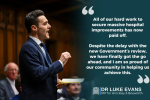
Time really does fly! A year ago, the then-Prime Minister stood at the dispatch box in the House of Commons in support of my Body Image Campaign and pledged that it would be incorporated in the Women’s Health Strategy.
If you didn’t already know, I’ve been calling for companies and influencers to voluntarily commit to not digitally alter a person’s body proportions in any of their imagery. For those who don’t sign up to my Body Image Pledge and still choose to distort body shapes, I believe a label – much like the product placement ‘P’ or #ad – should be included on images when a person’s waist has been edited to look slimmer, biceps enlarged or thighs trimmed down.
As a GP, before becoming your MP, I saw first-hand the effects that social media and digitally altered images can have on a person’s relationship with their body image and mental well-being. With an estimated 1.25 million people in the United Kingdom suffering from anorexia or bulimia, over 1 million people with Body Dysmorphic Disorder and anywhere between 500,000 to 1 million people using anabolic steroids, it’s a growing problem that needs our attention.
Last year 86 MPs from across seven different parties in Parliament signed my open letter to companies, brands and organisations which called for industry action against the digital manipulation of body proportions. Since then, the campaign has gone from strength to strength as companies such as Boohoo, Boots, Dove, Pretty Little Thing, Marks and Spencer, John Lewis, PureGym, Barry M Cosmetics, Aldi, Oasis, Karen Millen, Warehouse, Nasty Gal and Coast have signed up to the Pledge… with more to be announced over the summer!
I’m amazed when I’m out and about in our area just how strong the community feels about this. People of all ages and political persuasions, whether they’re just entering their teenage years or are grandparents concerned about the impact of platforms such as Instagram and TikTok, recognise the need for change.
Research on the impact of social media distorted images is substantial, and alarming. Recent figures from Girlguiding show that 51% of 7-10 year old girls feel ‘very happy’ with how they look. But by age 11-16, when most girls start to use social media, this drops significantly to just 16%.
To tackle this, I believe change needs to be made from the top down. Fashion and beauty brands, celebrities and influencers hold great influence online and by making this small change they have the opportunity to realign the societal expectations that put immense pressure on us to look a certain way.
Ultimately, I hope never to see a label. But if companies don’t act soon, I believe Government must step in. Norway already has legislation in place and France recently announced plans to do the same.
I’m encouraged to see this recognised in the Women’s Health Strategy and as recommendations from the Health Select Committee and Women and Equalities Committee. Progress is slow and difficult to track, but the important thing is that whichever side of the Parliamentary divide you fall on people are united in making a difference.







